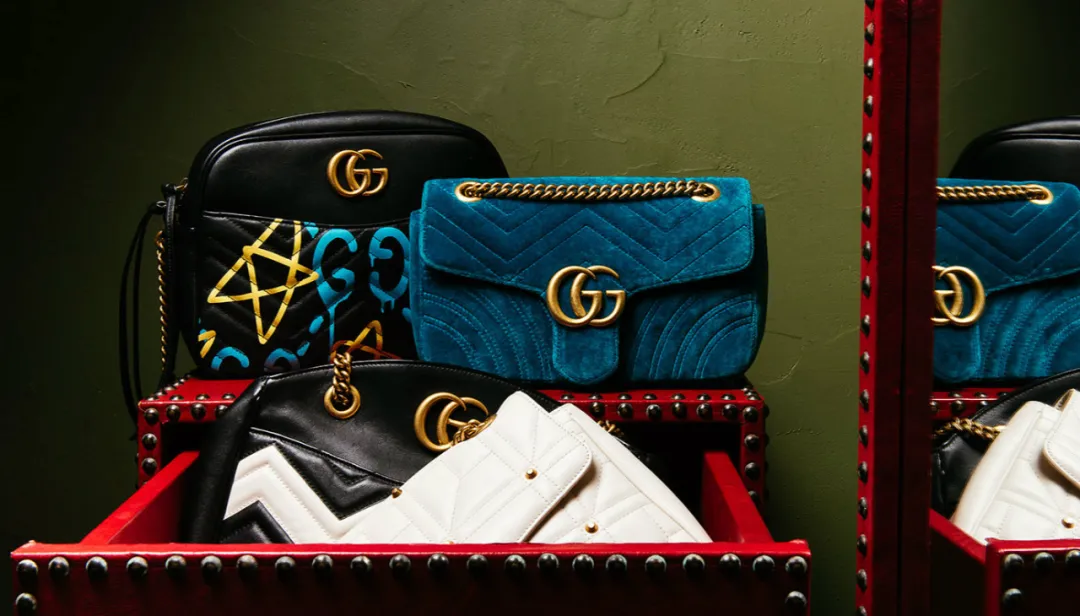Since 2017, when luxury brands introduced the sale of Qixi series online and launched a digital competition across the industry, the competition has become increasingly fierce. It is not only about products, but also a series of social media marketing activities.
Festival marketing is naturally understandable, after all, it is not a brand’s wishful thinking, but the market environment is determined by the habits of Chinese consumers shopping during festivals. Especially after the epidemic, the pressure on the global market has shifted towards the Chinese market, and the loss of abandoning any holiday node is incalculable for brands. Looking at the recent frenzy of luxury shopping malls and the surge in online sales, it is evident that the desire of Chinese consumers for luxury goods is the starting point of all market behavior.
Clarifying this background will help to understand Balenciaga’s recent series of Qixi controversies.
On August 10, Balenciaga launched a series of Qixi special handbags on social media, with Chinese characters “I love me”, “I love you”, “you love me” and “I love him” as design elements. Four styles were released and sold on the brand’s official website, Tmall’s official flagship store and four offline stores.
It is worth noting that in the almost identical red themed limited edition series of luxury brands, consumers who were originally prone to numbness were instantly completely stirred up by Balenciaga. Due to the unique shooting style of Balenciaga Qixi ads and the controversy caused by the product font, the microblog topic of # Balenciaga Qixi advertising soil # reached 210 million in just two days, and the WeChat index soared by 316% day on day yesterday.
The opinions of netizens are polarized, with some believing that it is unacceptable to be too down-to-earth, while others believe that advertisements have a sense of humor, reflecting the brand’s consistent independent attitude.
Most fashion culture enthusiasts belong to the latter, and Balenciaga’s advertisement did not surprise them very much. If the general public’s perception of Balenciaga is street style dad shoes, logo T-shirts, or at least a luxurious store located on the first floor of a shopping center with a sense of distance, then in the eyes of fashion culture enthusiasts, Balenciaga is seen as a brand that is biased on social media, passionate about meme culture and youth subculture.
We must acknowledge the disruptive innovation of the brand’s overall image and communication methods during the tenure of Brand Creative Director Demna Gvasalia.
Regardless of Balenciaga’s official Instagram account completely rebelled against the traditional operation mode of luxury brand social media, and purely released photos and inspirational pictures of ordinary people rather than brand content, Balenciaga’s recently opened Tiktok account also released a number of “nonsense” creative videos that seemed unrelated to the product, showing the brand core to Chinese consumers, although this was not easy to detect.
Some argue that Demna Gvasalia has completely betrayed the legacy of the high-end fashion house established during the Cristobal Balenciaga era. However, after experiencing the initial years of controversy, when we re-examine Demna Gvasalia’s works, we will find that in the process of transitioning from personal brand Vetments to Balenciaga, Demna Gvasalia not only continues its nostalgic style for everyday things and history, but also inherits the focus on silhouettes from the Cristobal Balenciaga era, bringing the brand recognizable exaggerated silhouettes such as towering shoulders.
In the current era of popular street trends, Demna Gvasalia has persisted in exploring a certain professional dimension and made her own achievements, which is a fact that many critics often overlook.
From fashion to brand visual communication, Balenciaga has established a brand new worldview. What Demna Gvasalia has done is not only nostalgia as always, but also imagination for the future. Starting from the previous season, Balenciaga has focused on creating an apocalyptic emotion that is both hopeless and romantic, blurring the timeline. The 2020 autumn/winter series will decorate the runway as a post apocalyptic world with low sky, amidst fire and water, and an abnormal climate. The advertisements in the 2020 Spring/Summer series are postmodern style news broadcasts filled with absurd visuals, cleverly echoing the global turmoil since 2020.
After combing the historical context of Balenciaga and looking at the controversial Chinese Qixi ads, it is not difficult to see that this is an extension of Demna Gvasalia’s aesthetic and world outlook.
A controversial focus is that many netizens believe that this advertisement is a mockery of Chinese aesthetics. However, in fact, the so-called crude special effects, 90s cinema style, and cheesy model calendars are not only unique to China.
Antoinette Love, a new media artist who designed the visual for this advertisement, used the innocent and vulgar style of greeting cards from the 1980s to depict typical European sweet love stories. Creative agency PZToday specializes in selling vintage quirky items and independent magazines, and has also collaborated with fashion brand Helmut Lang. Popular emerging designer Mowalola combines sexy and tacky tie dyed leather with African futurism, while Chinese fashion designer Yue Qiqi traces back to Guangdong’s urban lifestyle, using everyday objects such as spittoons as inspiration for her creations. Buffalo Zine, an independent fashion magazine, has also released covers in a similar retro calendar style.
These avant-garde European and American artists and creators, as well as ordinary European and American fashion students, are re embracing the aesthetic form of low precision and no retouching from decades ago. In the eyes of the public, it may be considered “ugly”, but in reality, it is a rebellion against the current overly embellished perfect fashion. The dazzling print patterns, studio family photos, and eight o’clock ethical dramas are the “unfashionable” history that we have experienced together in China, Europe, and the United States. Demna Gvasalia chose to embrace the history and roots that we all share.
Among some young Chinese people, although this culture has not yet given rise to clear propositions and forms, it has also rapidly spread. The millennial generation loves nostalgia and enjoys using outdated and exaggerated emojis. The short video of adding English music to the county town video has been widely circulated in young communities such as Bilibili, reflecting the increasingly open and relaxed attitude of young people. More and more young people are beginning to accept their culture and history, and feel confident about it.
It is worth noting that a keyword has emerged in this controversy, “soil”.
If there are relative public standards for beauty and ugliness, then the concept of “soil” is relatively vague. What is “earth”, is it outdated or vulgar? Is its antonym “foreign style”? When transitioning between Eastern and Western contexts, we cannot find a direct corresponding English vocabulary for “soil”. In the Western dominated fashion world, “foreign style” is an essential attribute, and there is no concept of “soil” at all.
When people use the term “unfashionable marketing” as they should, they actually assume that luxury brands are advanced, mysterious, and distant, while “unfashionable marketing” is self catering to the market. We need to further question whether such a assumption still holds true. The reality is that this sense of distance has been completely shattered after the emergence of social media.
The Balenciaga in Demna Gvasalia’s hands has clearly abandoned the traditional idea of creating social distance with a flawless and luxurious image, and instead uses avant-garde aesthetics to create aesthetic distance. The confusion from the public is a part of this aesthetic, and the transition from confusion to obsession is a highly adhesive process between consumers and brands.
Now we see two Balenciaga, one as a avant-garde fashion brand and the other as a commercial luxury brand. This is a unique phenomenon that has emerged in Balenciaga, where avant-garde fashion attitudes coexist with the success of mass commerce.
The public’s misunderstanding of the luxury brand Balenciaga lies in its trendy branding. But Balenciaga’s image in fashion shows and advertisements is clearly different from the “trendy” culture of Yeezy and Off White.
The huge controversy this time is also related to Balenciaga’s two images. The battlefield of Qixi marketing has always had a strong commercial flavor. Luxury brands have launched elaborately packaged Qixi gifts suitable for gift giving, with the purpose of nothing more than stimulating sales.
It is precisely at such a time when luxury brands focus on competing marketing means and media capital, and also at the bottleneck period when luxury brand Qixi marketing falls into excessive overflow and it is difficult to continue to stimulate a sense of freshness, Balenciaga instead chose to display the most radical and closest brand aesthetic image on Qixi.
Compared with the all red pieces, Balenciaga at least tried to provide some new ideas in the fierce but stereotyped Qixi marketing war. Although old photos in cinemas are filled with simple backgrounds, they often record the purest and sweetest emotions between people in the old era. In today’s emotionally complex and impetuous society, people actually miss this seemingly false and genuine emotion even more.
This also echoes the recent theme presented by Balenciaga, who unexpectedly launched a 2020 autumn advertisement with the theme of “living out love” amidst the gloomy apocalyptic complex of the autumn and winter series. It can be seen that emphasizing the power of love in the despair of the apocalypse is Balenciaga’s postmodern solution. The different slogans on the four bags of the Qixi series actually emphasize the consistent theme of “Love is for everyone”.
For consumers who only know the luxury brand Balenciaga, everything in front of them is bound to be confusing and even challenging common sense. Because this is the attribute of social media, which always presents fragmented information and quickly triggers emotional switches in the absence of context. Meanwhile, the attributes of social media also lead more people to feel that luxury brands are related to themselves, even for non brand target consumer groups.
If this controversy is simply understood as another luxury brand to cater to the Chinese market and put down its posture to carry out “unfashionable marketing”, the crisis of public opinion caused by the lack of reasonable control of discretion is almost meaningless to the market and will only make the brand more conservative and commercialized, which is exactly the focus of the current consumer market’s criticism of luxury brands.
Disputes can bring about arguments and communication, or at least expose contradictions and discover problems. Just like the controversy caused by the poster design of the Beijing International Film Festival not long ago, people in the information cocoon room finally saw how divided the views on the Internet can be, but this time the voice of the mass market overshadowed the voice of a small number of fashion lovers and avant-garde subculture.
We need to admit that the group of people who purchase Balenciaga logo T-shirts and identify with Demna Gvasalia may never be the same, and this is a gap that the brand needs to continuously bridge through communication in the future. But more importantly, how brands can persist in themselves in such a market.
The avant-garde position determines that the brand will inevitably make some consumers feel uncomfortable, which is understandable. In today’s era, unclear stance and following the trend may be the most dangerous strategy. Success often only requires grasping the core of things and making the core strong enough, rather than being comprehensive and delivering works without uniqueness. Many times, controversy is directly proportional to value. In this era that does not reject being out of place but detests mediocrity, achieving the utmost in anything is value.
From the simplest market perspective, Balenciaga actually achieved a complete victory this time. The unprecedented topic discussion brings the ultimate advertising effect, not only a huge promotion of the Hourglass hourglass bag, but also a one-time push of the hourglass bag, which was previously limited to fashion enthusiasts, to the mass market. At the same time, such discussions are also a re understanding of the Balenciaga brand in the mass market, helping consumers enrich their understanding of the Balenciaga image.
Now Demna Gvasalia has taken over the creative power of Balenciaga for over three years, and the entire brand is constantly striving in terms of design, management, and sales.
Never underestimate the influence of social media topics, elongate the timeline, and consumers will vote with real gold and silver. As a highly anticipated second tier brand of Kaiyun Group, Balenciaga may also need such a resurgence of popularity.




















